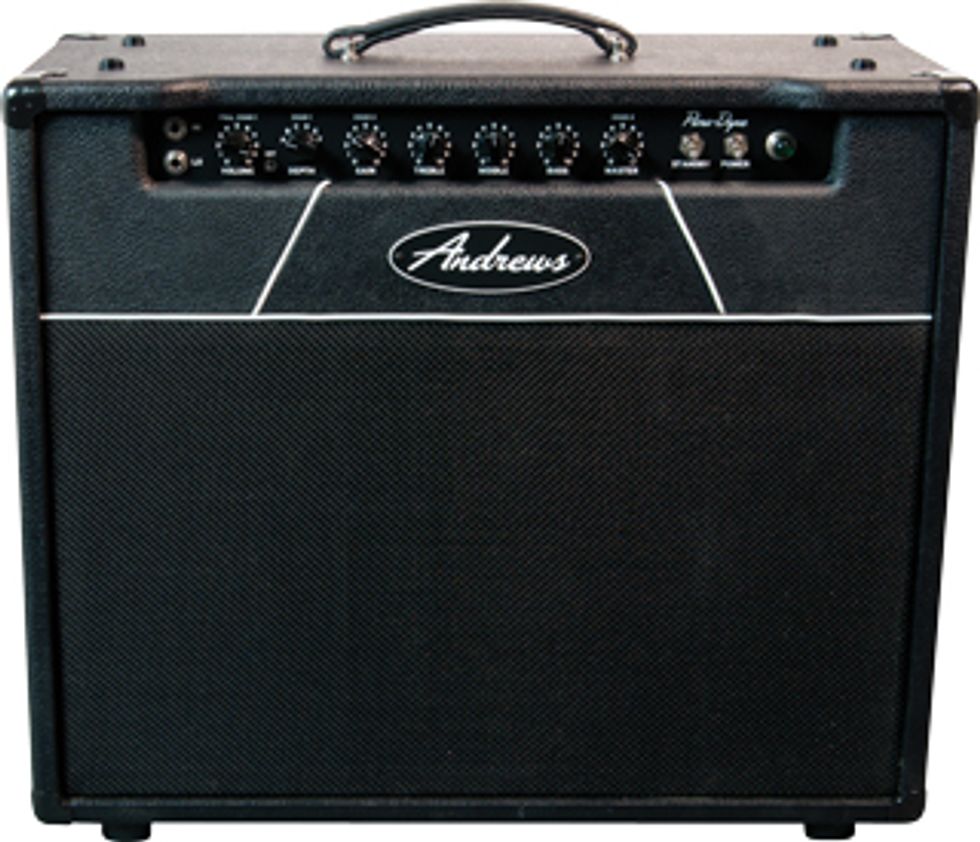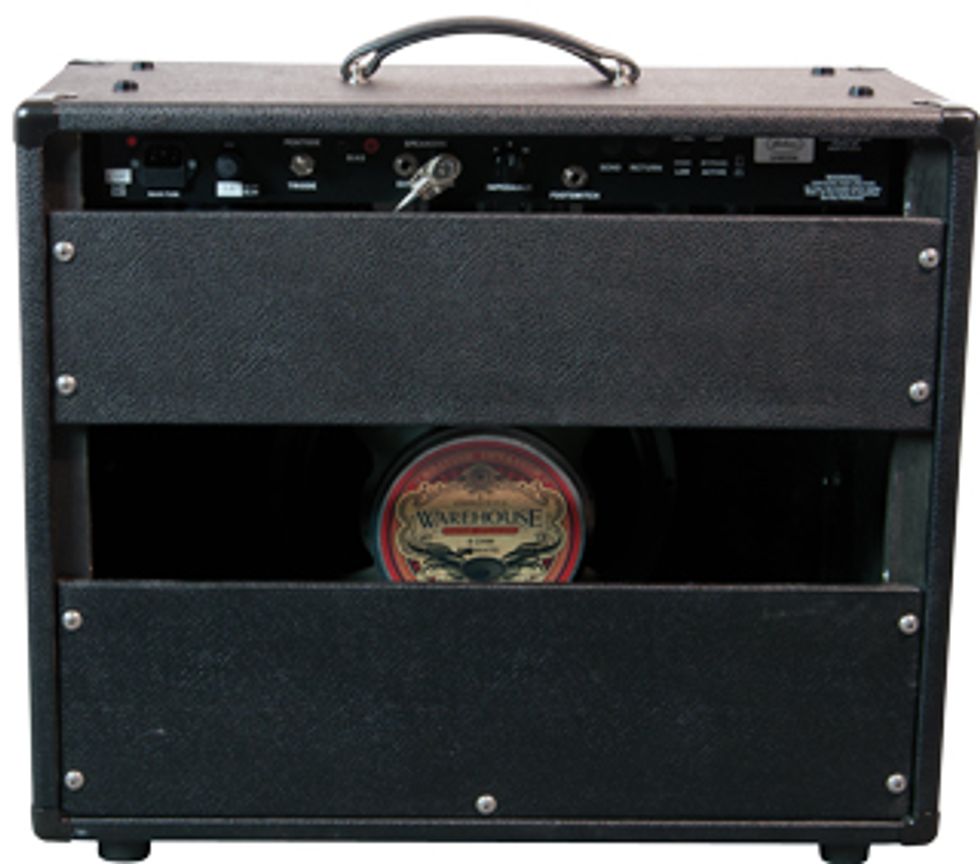
Having tinkered with guitar amplifiers since the late ’70s, Jeff Andrews has had plenty of time to accrue down-and dirty, hands-on circuit-tweaking experience and develop a keen taste for tone and control. In 2002, he launched his service business—Andrews Amp Lab—in Atlanta, Georgia, after years of working for a large Japanese electronics corporation.
It wasn’t long before Andrews got the building bug and unleashed the first Andrews Amplification amp with the A-Series. Now, Andrews has set sail with the second-generation Para-Dyne series. Boasting two dynamic channels (hence the name) the Para-Dyne line aims to sidestep issues of paunchy compression and deliver a stalwart, responsive tone that can be shaped through its inventive EQ control. The Para-Dyne 50 combo reviewed here delivers on those promises and more.
Highly Refined
The Para-Dyne is available in 20- and 50-watt
models as a head or combo (jazz/blues jam-ace
Jimmy Herring uses the Para-Dyne 50
head). The Para-Dyne 50 combo we checked
out houses a single 12" Warehouse Veteran
30 speaker, two EL34s in the output circuit,
and three 12AX7s in the preamp.
Space is used wisely on the Para-Dyne 50 and Andrews manages to keep things simple while optimizing use of both channels. Channel switching is achieved with a footswitch or by pulling out the leftmost volume pot. This bypasses channel 2’s gain knob and engages the depth control. The 6-position rotary depth switch works exclusively with the clean channel and is used to fine-tune bass response. It’s a cool control when used in conjunction with the regular EQ, and a smart way to dial in a robust, clean tone if you’re switching between channels.
Tones from the clean channel can also be shaped using the 3-position bright (brt) switch. The down position reduces brightness, the middle position is more or less neutral, and the up position makes things considerably brighter. The treble, mid, and bass controls are interactive, so adjusting one parameter to any significant extent will most likely require you to fine-tune the others. It takes a little practice to get a feel for how it works, but in the end, the additional flexibility is a big plus. Finally, the master volume adjusts the loudness of channel 2 and is used in conjunction with the gain to tame or unleash overdriven tones.

The rear panel of the Para-Dyne 50 is home to a multitude of features, including a useful and most welcome pentode/triode switch. Pentode mode is effectively the amp at full power—which is great for larger gigs and louder jam sessions. Kicking down into triode reduces the output power by half and enables a more full-bodied overdrive at lower volumes that will keep curmudgeonly neighbors at bay. Andrews also offers an optional buffered and bypassable serial-effects loop for the Para-Dyne series. And if you’re thinking about using an external cab, just plug into the main jack and change to the proper impedance with the 4/8/16 Ω selector. A secondary cab can also be added through the extension jack.
Cosmetically, the Para-Dyne combo exudes a simple but sharp-dressed character that’s sort of a cross between Vox, Matchless, and Hiwatt sophistication. Diagonal, white piping breaks up the flat, black expanses of vinyl on the front panel in minimal-but-stylish fashion. While this is only a 1x12 combo, the amp is actually quite heavy. But with its hefty, finger-jointed birch cabinet, it’s definitely built to last.
Dirty & Dapper
The coupling of a Stratocaster and an
EL34-driven amplifier can be magical—a combination of basic blues tone and a
nasal distortion that excites the blood, and
the essence of the guitar “stink” that so
enthralled Frank Zappa. The Para-Dyne’s
overdrive channel excels at delivering these
types of tones. It can sound simultaneously
nasty and refined, and it was easy to dial
out fat, compressed sounds. Inevitably,
you’ll definitely hear things get a little more
round and chugging in the higher-gain
placements, but the Para-Dyne retains an
airiness—a bit of breathing room, really—that gives you leeway to shape your tone
in specific ways at more extreme levels.
With the gain around 5, you’ll have a
solid foundation for excited Hendrix-style
breakup—biting but sweet with sustain
that’s pronounced and pleasing, but not too
squirrelly. And with careful use of the gain
control, you can get to that sustain sweet
spot at lower volumes too.
Ratings
Pros:
Versatile channel switching. Plenty of headroom.
Effective tone-shaping features.
Cons:
Might be expensive for a lot of folks moving up to
50 watts.
Tones:
Ease of Use:
Build:
Value:
Street:
$2,350
Andrews Amplification
andrewsamplab.com
With their wide, fat, harmonic range, humbuckers demand a bit more attention on the tone-shaping side. A Gibson Les Paul through the lo input took on a darkly shaded personality and felt a bit claustrophobic and stifled. This was especially apparent on the second channel where you’re without the bright switch. Cutting these waters is still possible with a significant boost in treble and cutting the bass EQ, but you may as well just plug into the hi input, corral the top end, and enjoy the wider range of the tone control. With channel 1 engaged, you have the depth control to help carve up the low end and make the environment more humbucker friendly. A neutral setting is definitely a good starting point that will suit most situations, including single-coils. But if you use humbuckers with any frequency, you’ll love what the depth control—and its power to tame woofy low end—can do to enliven a humbucker and coax a little burn and high-end detail back into the mix.
The Verdict
It can feel dicey making a single amp a
cornerstone of your tone. And when you
get into the 50-watt range—where things
get expensive fast—finding that one
amp with the most possibilities gets even
trickier. What’s cool about the Para-Dyne
50 is that it isn’t a one-trick pony. Its basic
voice channels the essence of a good EL34
amp—a capacity for chime and power that
can shine brightly with single-coils, or take
on a darker, burlier, and feisty voice with
humbuckers. Both channels are very useable
and can be set up for effective, multi-voiced
channel switching if you do a little
homework and really investigate how wide
in range and interactive the tone, gain, and
voicing controls can be.
It’s a great amp for Americana, classic rock, and pedal-dependent indie and experimental-rock environs. Although the Para-Dyne 50 serves up plenty of gain for most applications, real heavy music heads will likely want for a closed-back cab and hotter speaker. That said, the Para-Dyne 50 can kick with real aggression, depending on how you employ the EQ and use the internal trim control to adjust the range of OD. It’s of little surprise that an amp-service specialist—who sees the good, the bad, and the ugly—developed the Para-Dyne 50. For it’s an amp of plentiful and real strengths—without any true Achilles heel. But that solid, fundamental performance doesn’t make it any less a player’s amp, and with its copious power and all the easy-to-use tone-control tools that it puts at your fingertips, it’s an amp that will have your back in just about any stage situation you can imagine.







![Rig Rundown: Russian Circles’ Mike Sullivan [2025]](https://www.premierguitar.com/media-library/youtube.jpg?id=62303631&width=1245&height=700&quality=70&coordinates=0%2C0%2C0%2C0)


























